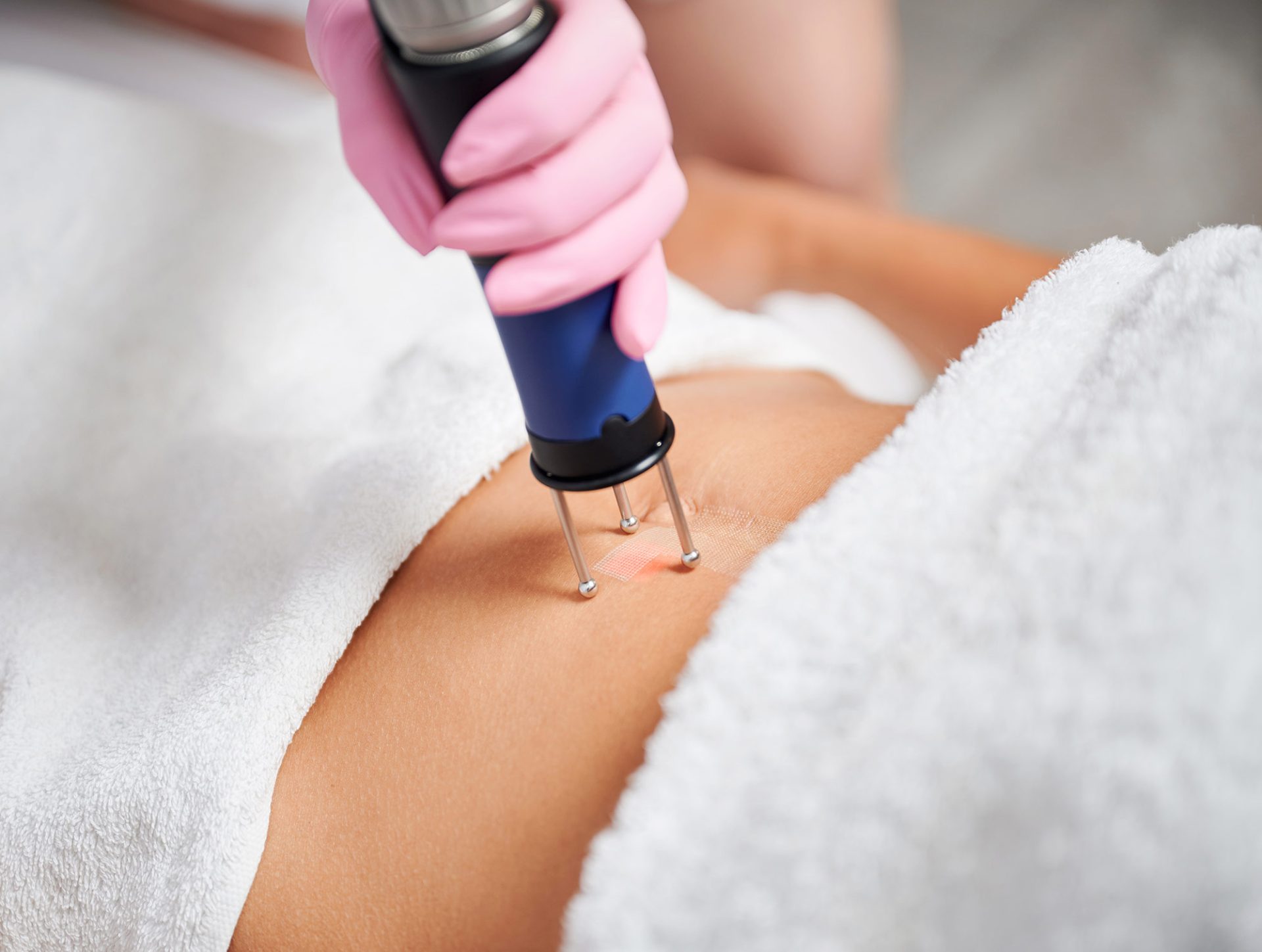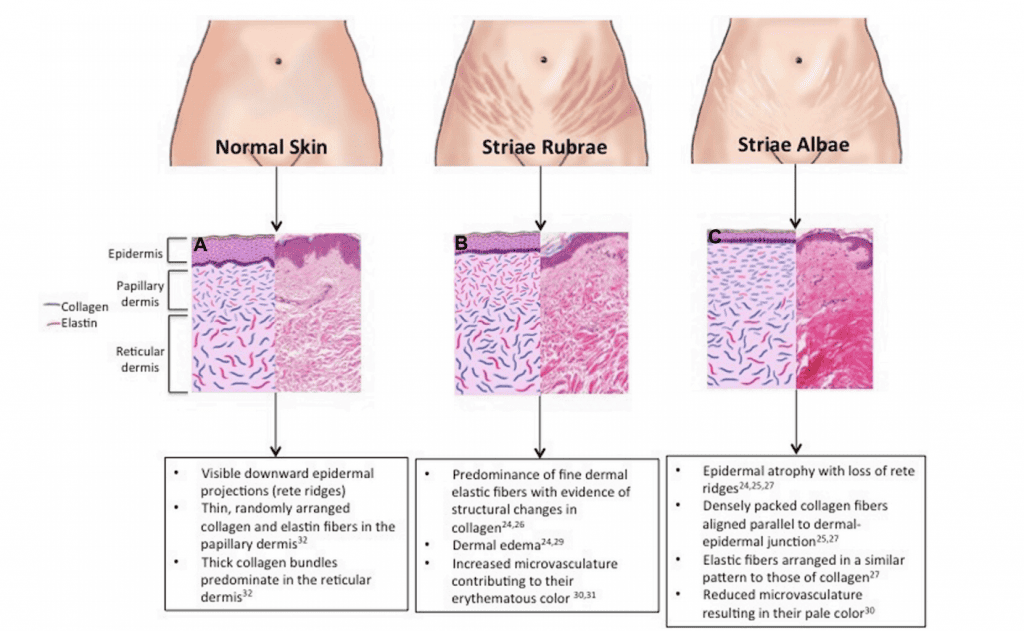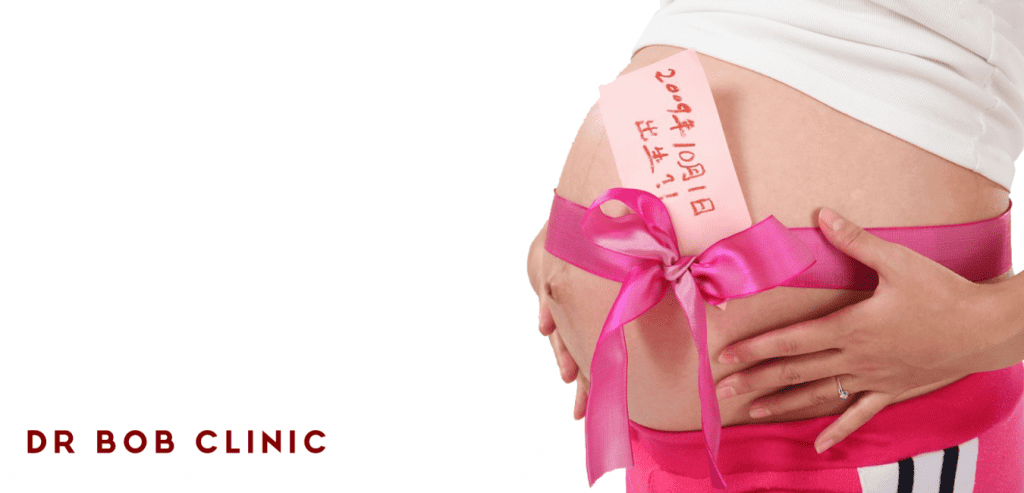Stretch Marks Removal Treatments

Understanding Stretch Marks
Stretch marks are fine lines that become apparent on the body when there is tearing of tissues under your skin from rapid growth or over-stretching. It is a common condition that does not result in significant medical problems but can be a matter of cosmetic concern. Clinical names for stretch marks are striae rubrae (which are red) and striae albae (white) striae atrophicans (thinned skin), striae gravidarum (following pregnancy), striae distensae (stretched skin), striae nigrae (black) and striae caerulea (dark blue).
What do stretch marks looks like?
An early sign of stretch marks developing is when an area of skin becomes flattened and thin with a pink colour. This may also occasionally be itchy. Soon reddish or purplish slightly swollen lines develop perpendicular to the direction of skin tension (striae rubrae). The terms striae caerulae (blue) and striae nigrae (black) have been used to describe striae distensae that appear darker than usual due to increased melanization. Subsequently, these lighten to become either hypopigmented or flesh-coloured and much less conspicuous (striae albae). Stretch marks are usually several centimetres long and 1–10 mm wide. The direction of the striae is determined by the mechanical forces responsible, but they are usually linear. Those caused by corticosteroid use or Cushing syndrome are often larger and wider and may involve other regions, including the face.

Causes of Stretch Marks
The exact cause of stretch marks is still unclear. There are different hypotheses on the development of stretch marks in the literature
- Infection leading to the production of striatoxin that damage the tissues in a microbial toxic manner
- Mechanical effect of stretching, leading to rupture of the connective tissue framework (e.g., pregnancy, obesity, weight lifting)
- Normal growth as seen in adolescence and the pubertal spurt that leads to increase in sizes of certain body parts
- Increase in the levels of body steroid hormones; Cushing’s syndrome, local or systemic steroid therapy having an inhibitory effect on fibroblasts
- Genetic factors (As suggested by the absence of striae gravidarum in people with Ehlers‐Danlos syndrome and the presence of stretch marks as one of the minor diagnostic criteria for Marfan syndrome)
- Immunosuppression states associated with certain drugs, human immunodeficiency virus or diseases such as tuberculosis
- Chronic liver disease association
- Striae gravidarum occur in more than half (approximately 50% to 90%) of pregnant women because of the separation of underlying connective tissue as the uterus enlarges within the abdominal cavity. Dermal collagen is damaged and blood vessels dilate, resulting in the formation of reddish-purple early stretch marks. Collagen remodeling frequently leads to loss of melanocytes, which leads to the hypopigmented mature stretch marks. Pregnancy related stretch marks tend to occur primarily on the abdomen, thighs, and breasts. A woman’s skin type and genetic history play a significant role in the extent of the striae.
Pregnancy stretch marks (Striae Gravidarum)
Striae gravidarum occur in more than half (approximately 50% to 90%) of pregnant women because of the separation of underlying connective tissue as the uterus enlarges within the abdominal cavity. Dermal collagen is damaged and blood vessels dilate, resulting in the formation of reddish-purple early stretch marks. Collagen remodeling frequently leads to loss of melanocytes, which leads to the hypopigmented mature stretch marks. Pregnancy related stretch marks tend to occur primarily on the abdomen, thighs, and breasts. A woman’s skin type and genetic history play a significant role in the extent of the striate.

Skin Laxity
Apart from stretch marks, another common condition that many women suffer from after childbirth would be skin laxity over the abdominal area from overstretching by the expanding uterus. This can lead to unsightly sagging skin that appears wrinkly.
The treatment for skin laxity on the abdomen is similar to the treatment that is used for nonsurgical facelift. Fortunately, the treatments for stretch marks work just as well for skin laxity.
Treatments Available For Stretch Marks In Malaysia
Throughout history, although many therapies for stretch marks has been tested, the results are often modest. This is possibly because the wound remodelling capacity of the skin is simply not resilient enough to overcome the extent of damage to collagen and elastic fibres when skin is stretched beyond its recoil capacity. This may be particularly so on the body where the vascular supply is limited and wound healing slower compared to facial areas. Despite these limitations, patients would often appreciate some degree of improvement where complete clearance is not possible.
Although numerous treatment methods have been attempted to improve the clinical appearance of stretch marks, most of them provide inconsistent and less than satisfactory outcomes.
Topical medications
The most common therapy is the application of topicals used both therapeutically and prophylactically. However, there is a distinct lack of evidence for topical formulations. In conclusion, there is no topical formulation, which is shown to be most effective in eradicating or improving stretch marks.
Studies have shown that vitamin A derivatives can been used successfully in the treatment of striae rubrae, but of limited value for striae albae. Treatment has to be administered for a duration of up to 6 months. The results showed a reduction in length and width of the stretch marks. Unwanted adverse effects include redness and scaling during the first few months.
Hyaluronic acid is an organic substance found in human skin and is the main constituent of Dr Bob Remedies Hydromax Essence. The hyaluronic content stimulates fibroblast activity and collagen production to restore any inhibition and collagen loss induced by hormonal fluctuations or mechanical stretch. The application of hyaluronic acid containing products can markedly lower the incidence of stretch mark development after pregnancy.
